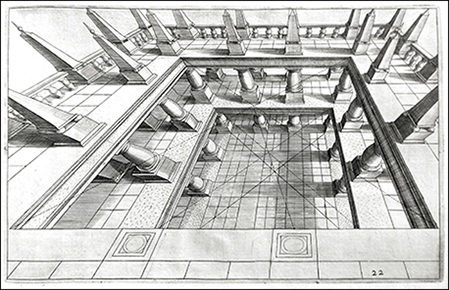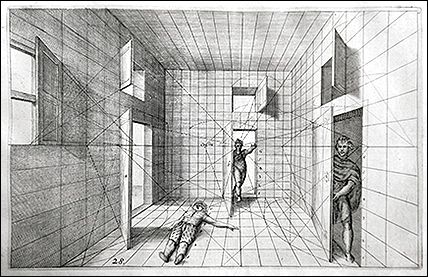Putting things in perspective
When two-thirds of the city of London burned to the ground in the Great Fire of 1666, the job of rebuilding the fifty-one churches that were destroyed, including the largest, St. Paul's Cathedral, fell to a promising young mathematician and astronomer named Christopher Wren, who had only recently begun to take an interest in architecture. During his long life, Wren would go on to design many of England's most well-known structures, including Kensington and Hampton Court palaces and the library at Trinity College, Cambridge. Although he had many sources of inspiration, one of them, we can be sure, was an oblong folio of seventy-two architectural engravings by the Dutch painter and architect Jan Vredeman de Vries. Published in Leiden by Hendrik Hondius in 1604 and bearing the simple title Perspective, Wren is known to have acquired a copy of the book for his personal library.
The LSU Libraries' Special Collections is pleased to announce that it, too, now owns a copy of this important and influential book on the art of three-dimensional drawing, a work that would have been used by architects, painters, set designers, sculptors, and engravers throughout Europe in the seventeenth century.
Born in 1527 in the Dutch province of Friesland, Jan Vredeman (whose first name sometimes appears as Hans or Johan) began his life as a painter. Like Christopher Wren, however, he has come to be remembered primarily for his contributions to architecture. Despite political and religious turmoil, the Netherlands in the sixteenth century was fertile ground for a creative mind such as his. The artistic ideals of the Italian Renaissance were finally taking root in places like Holland, Germany, England, and Scandinavia. One of those ideals, linear perspective, had been formulated in the 1400s and then further developed in the following century, setting the stage for masterpieces of realism such as Leonardo da Vinci's The Last Supper and bringing art into the modern age. In Germany around the time of Vredeman's birth, the great painter and theorist Albrecht Dürer had written about perspective in a four-part treatise titled Institutiones Geometricae (1532), another landmark in the history of art and architecture which the LSU Libraries Special Collections recently acquired a copy of. Realizing that a picture is worth a thousand words, Vredeman turned his attention to providing illustrations of what Dürer and earlier writers on perspective had been talking about.
Using the simple concept of vanishing points, by which one can create the illusion of three-dimensional space on a flat surface, Vredeman composed an astonishing series of imaginary architectural vistas and interiors that featured notoriously difficult things to draw in perspective, such as spiral staircases and the undersides of domes. Many of the images have an odd, dreamlike quality reminiscent of the work of another Dutch artist, M. C. Escher, who, in the twentieth century, took perspective even farther into the realm of fantasy. Some art historians regard Vredeman as a precursor of the Surrealists, and several art museums have exhibited his work alongside that of modern masters such as Hans Bellmer, Giorgio de Chirico, Salvador Dali, Marcel Duchamp, and Joan Miró. "His books," one scholar has written, "are fantasies and textbooks, dreams and pattern-books for apprentices, avant-garde messages and popular pictures—all at the same time."
—Michael Taylor, Assistant Curator of Books


